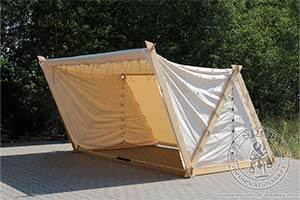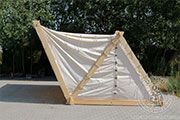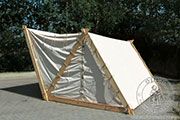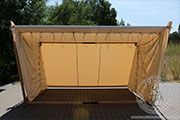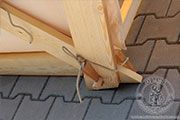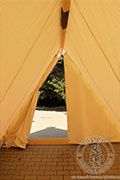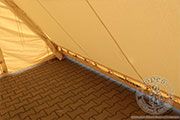If you wish to adjust your cookie preferences for this website, you can do so using your browser settings.



Category: Tents > cotton tents
Medium Viking tent from Oseberg (4 x 2,1 m) - cotton
Medium Viking tent from Oseberg (4 x 2,1 m) - cotton
Century: V-IX, X, XI| CODE | Material |
Standard
|
Price | |
| TNBS1634 | Cotton | Mixed | 1790.00 EUR |
|
| TNLS1635 | Cotton | Mixed | 890.00 EUR |
|
Lowest price in the last 30 days
See how to place an order for several people
Early medieval tent, made of impregnated cotton with a grammage of about 340 g/m2, resting on a wooden frame. The planks, each about 260 cm long, fold into two triangles on the sides of the tents. The others, each 300 cm long, form the frames of the base. The Oseberg tent is stabilized by a two-piece horizontal crossbar and a one-piece vertical pole. This type of tent was very popular in the early medieval period, especially in Viking culture.
There are many ways to set up an Oseberg tent.
- you can leave it in the form of a triangle and enter through the side opening wall
- or open it with additional boards, so that the tent turns into a touring stall
Note - in the "stall" version we recommend setting it up with 3 persons, and in the "tent" version - 2 are enough.
This versatile tent will work well both for an event in an early medieval camp and especially inspired by the Viking times. Interestingly, the wooden frame allows you to set up the tent on unnatural ground (such as cobblestones), as the tent does not need lashings or tent pins.
The Oseberg tent is available in two options:
TNLS1635 - version without a frame - at a very attractive price
TNBS1634 - version with a frame - a slightly more expensive version, mainly due to transportation costs
The dimensions of this historic tent are: 4m (width) x 3m (depth) x 2.1m (height).
The set consists of:
- 1 tent sheet
- 2 planks used to set up the base, each 3 m long
- 6 vertical planks used to set up the entire frame, each 2.6m long
- 4 poles divided in half (connected by steel profiles) that determine the width of the tent, each 4 m long
It is possible to order a frame with carved sideboards in the Viking style. If you are interested in such an option, please contact Customer Service before placing your order. Such option will be priced individually.
Oseberg tent?
Due to the fact that few Viking era objects have survived to the present day, we can only guess at most of the shapes of ancient tents.
Reports created during archaeological studies of burial remains from Oseberg (9th century) and Gokstad (9th century) allow us to at least approximate the possible appearance of Viking tents. They were mainly set up on the decks of ships, but it was possible to camp in them outside the boats.
Our tent got its name after the first of the burials - Oserberg. Mainly because thanks to the documents, left over from archaeological research, describing the exact appearance of the tents found on board ship, it was possible to reconstruct their frames. In addition, drawings of the side planks, on which fantastic animals were depicted, have been preserved.





 Female Clothing
Female Clothing Male clothing
Male clothing Accessories
Accessories Furniture
Furniture
 Armament
Armament HMB Line
HMB Line Miscellaneous
Miscellaneous Rent
Rent In stock
In stock Special Offers
Special Offers Search
Search Your Account
Your Account About us
About us Sizing
Sizing How to buy
How to buy Blog
Blog Links
Links Events
Events
